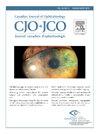Long-term visual outcomes and fluid compartment changes in limited-early versus early response to anti-VEGF treatment for diabetic macular edema
IF 3.3
4区 医学
Q1 OPHTHALMOLOGY
Canadian journal of ophthalmology. Journal canadien d'ophtalmologie
Pub Date : 2024-07-31
DOI:10.1016/j.jcjo.2024.06.004
引用次数: 0
Abstract
Objective
This study assessed best visual acuity (BVA) and central subfield thickness (CST) outcomes for LER (limited early responder) and ER (early responder) patients at 24 and 36 months.
Design
Retrospective chart review
Participants
One-hundred and twelve patients characterized at 3 months after their first anti-VEGF injections as either LER if they met the anatomic criteria (aLER = CST reductions ≤ 10%), visual criteria (vLER = ETDRS letter gains < 5 letter), or both (cLER). All other patients were classified as ER (aER/vER/cER).
Methods
Variables collected include CST and ETDRS letters at baseline, 3, 24, and 36 months following injections, comorbidities, smoking status, demographics, baseline systemic factors, and the type and quantity of anti-VEGF injections. Analyses were performed using Welch's t-test, multivariable linear and multivariable logistic regression.
Results
BVA changes from 3 months were significant between cLER versus cER and vLER versus vER groups (p < 0.05). There was a greater decrease in mean BVA from 3 months to 36 months in the cER group compared to the cLER group. Alternatively, mean BVA decreased in the vER cohort, while the vLER cohort slightly increased. CST changes from 3 months were statistically significant (p < 0.01) between all LER and ER groups with LER groups showing greater reductions compared to ER counterparts. BVA and CST changes from baseline to 24 and 36 months were not significant after controlling for baseline differences between LER and ER groups.
Conclusion
Results highlight the value of long-term anti-VEGF treatment and the need to further explore options that may lead to continued BVA improvements beyond 3 months.
Objectif
Notre étude a examiné la meilleure acuité visuelle (MAV) et l’épaisseur du sous-champ central (ESC) des patients qui ont bénéficié d'une réponse précoce limitée (RPL) et d'une réponse précoce (RP) au traitement anti-VEGF à 24 et à 36 mois.
Nature
Revue rétrospective des dossiers médicaux
Participants
Ainsi, 3 mois après la première injection d'anti-VEGF (facteur de croissance endothélial vasculaire), on a réparti 112 patients en fonction de leur réponse : RPL s'ils répondaient aux critères anatomiques (RPLa = baisse de l'ESC ≤ 10 %), aux critères visuels (RPLv = gains de < 5 lettres selon l'ETDRS) ou les 2 (RPLc). Tous les autres patients ont été classés dans le groupe RP (RPa/RPv/RPc).
Méthodes
Les variables recueillies comprenaient la mesure de l'ESC et des lettres ETDRS au départ de même que 3, 24 et 36 mois après les injections, les affections concomitantes, le tabagisme, les caractéristiques démographiques, les facteurs systémiques initiaux et, enfin, le type et le nombre d'injections d'anti-VEGF. Les analyses reposaient sur le test t de Welch, la régression multivariée linéaire et la régression logistique multivariée.
Résultats
Les variations de la MAV à 3 mois étaient significatives, selon que le patient a eu une RPLc comparativement à une RPc, ou une RPLv comparativement à une RPv (p < 0,05). On a enregistré une baisse plus marquée de la MAV moyenne entre la mesure à 3 mois et celle à 36 mois dans le groupe RPc, comparativement au groupe RPLc. Par ailleurs, la MAV moyenne a diminué dans le groupe RPv, tandis qu'elle a augmenté légèrement dans le groupe RPLv. Les variations de l'ESC à 3 mois étaient significatives sur le plan statistique (p < 0,01) entre tous les groupes RPL et RP, les groupes RPL ayant bénéficié d'une baisse plus marquée comparativement aux groupes RP. Les variations de la MAV et de l'ESC à 24 et à 36 mois, par comparaison aux valeurs de départ, n’étaient pas significatives une fois prises en compte les différences initiales entre les groupes RPL et RP.
Conclusion
Nos résultats soulignent l'intérêt d'un traitement anti-VEGF au long cours et l'importance d'examiner plus à fond les options qui peuvent engendrer des améliorations persistantes de la MAV au-delà de 3 mois.
糖尿病黄斑水肿抗血管内皮生长因子治疗早期反应与有限反应的长期视觉疗效和液体分区变化。
目的:本研究评估 LER(有限早期反应者)和 ER(早期反应者)患者在 24 个月和 36 个月后的最佳视力(BVA)和中央子场厚度(CST):本研究评估了 LER(有限早期反应者)和 ER(早期反应者)患者在 24 个月和 36 个月时的最佳视力(BVA)和中央子场厚度(CST)结果:设计:回顾性病历审查 参与者:112 名患者112 名患者在首次注射抗血管内皮生长因子 3 个月后,如果符合解剖标准(aLER = CST 降低≤10%)、视觉标准(vLER = ETDRS 字母增益 < 5 个字母)或两者(cLER),则被归类为 LER。所有其他患者均被归类为 ER(aER/vER/cER):收集的变量包括基线、注射后 3、24 和 36 个月的 CST 和 ETDRS 信度、合并症、吸烟状况、人口统计学、基线全身因素以及抗 VEGF 注射的类型和数量。采用韦尔奇 t 检验、多变量线性回归和多变量逻辑回归进行分析:cLER 组与 cER 组、vLER 组与 vER 组之间 3 个月的 BVA 变化显著(p < 0.05)。与 cLER 组相比,cER 组从 3 个月到 36 个月的平均 BVA 下降幅度更大。另外,vER 组的平均 BVA 有所下降,而 vLER 组则略有上升。所有 LER 组和 ER 组从 3 个月到 36 个月的 CST 变化均具有统计学意义(p < 0.01),其中 LER 组与 ER 组相比下降幅度更大。在控制了LER组和ER组的基线差异后,BVA和CST从基线到24个月和36个月的变化并不显著:结果凸显了长期抗血管内皮生长因子治疗的价值,以及进一步探索可在 3 个月后继续改善 BVA 的方案的必要性。
本文章由计算机程序翻译,如有差异,请以英文原文为准。
求助全文
约1分钟内获得全文
求助全文
来源期刊
CiteScore
3.20
自引率
4.80%
发文量
223
审稿时长
38 days
期刊介绍:
Official journal of the Canadian Ophthalmological Society.
The Canadian Journal of Ophthalmology (CJO) is the official journal of the Canadian Ophthalmological Society and is committed to timely publication of original, peer-reviewed ophthalmology and vision science articles.

 求助内容:
求助内容: 应助结果提醒方式:
应助结果提醒方式:


